Classroom furniture has come a long way from the traditional static desks and chairs of the past. Today’s schools are investing in furniture that adapts to evolving teaching methods and student needs. In modern classrooms, desks and chairs are not just places to sit and write – they play an active role in enhancing learning. Several key trends are shaping the design of school desks and chairs, including the use of new materials, innovative designs, and greater flexibility in how furniture is used.
Sustainable and Innovative Materials
One major trend is the shift toward sustainable materials in school furniture. Schools and manufacturers alike are prioritizing eco-friendly and durable materials for desks and chairs. For example, many modern school desks are made with recycled plastics or wood certified by sustainable forestry programs, instead of non-renewable or high-emission materials . These materials not only reduce environmental impact but also tend to be very durable, meaning the furniture can withstand years of use by energetic students. Innovations in materials also include scratch-resistant laminates and low-VOC finishes (finishes with fewer harmful chemicals), which make furniture safe and long-lasting. By integrating greener and sturdier materials into student desks and chairs, schools align with global efforts to reduce their carbon footprint while getting furniture that stands up to daily wear and tear.
Modern Design and Aesthetics
Another trend is the move toward modern, student-friendly designs for classroom furniture. Instead of the old-fashioned, one-size-fits-all desk, we now see a variety of shapes and styles that create a more engaging environment. Manufacturers are moving away from dull, uniform looks and embracing vibrant colors and sleek, contemporary aesthetics in school desks and chairs . This means classrooms might feature desks with smooth curved edges, chairs in bright or calming colors, and furniture that feels less institutional. The idea is that a visually appealing classroom can make students feel more welcome and inspired. Modern design also extends to functionality: many new desk designs include features like built-in storage trays or hooks for backpacks, and some even integrate technology (such as outlets for charging devices) seamlessly into the desk. Importantly, design trends are student-centric, often involving input from educators and students to ensure the furniture meets real classroom needs. The result is furniture that not only looks better but also supports collaboration and active learning – for instance, kidney-shaped or round tables encourage group work, and movable partitions or whiteboard surfaces on desks invite interaction.
Flexibility and Adaptability in Furniture
An example of a modern learning space with soft, modular seating that can be rearranged for different activities. Flexibility is perhaps the most defining trend in modern school furniture. Gone are the days when heavy desks were bolted to the floor; today’s flexible classroom furniture allows teachers and students to rearrange spaces easily. Desks and tables are often on wheels or light enough to carry, and many chairs are stackable or foldable for quick reconfiguration. This adaptability lets educators swiftly transition a classroom from a traditional lecture layout to a group discussion setup, or even an open area for hands-on activities.
In fact, flexibility is now seen as paramount in classroom design. The classic rigid desk-and-chair set is evolving into modular designs that can be moved or adjusted as needed. Height-adjustable student desks that accommodate different activities (sitting or standing) are becoming more common. As one industry report noted, classroom furniture is being designed to be easily reconfigured – adjustable desks and foldable chairs are becoming classroom staples . All of this supports modern teaching methods like project-based learning and collaborative work, as well as the need to utilize classroom space efficiently. Additionally, many classrooms now offer alternative seating options – such as stools, floor cushions, or lounge-like chairs – in reading nooks or group zones. These choices let students find comfortable postures and can be especially engaging for younger learners.
Post time: Apr-19-2025








